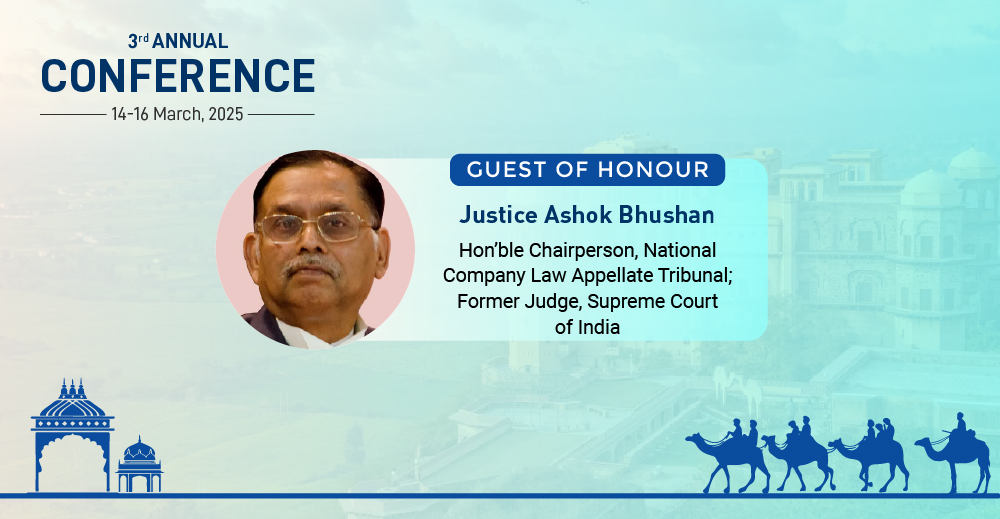
Address by the Guest of Honour at the 3rd Annual Conference
Justice Ashok Bhushan, Hon’ble Chairperson, National Company Appellate Tribunal*
I feel privileged and honored to be before you in this gathering of experts and eminent persons who have contributed towards the development of insolvency law. I thank the organizers especially Justice Arjan Kumar Sikri for inviting me to this Annual Conference.
I would like to start my speech by complimenting the organizers for bringing together excellent topics on the floor of discussion. The topics of discussion are highly relevant in today’s context not only for India but for other international jurisdictions as well.
In India, before 2016 insolvency laws were fragmented across numerous statutes, leading to inefficiencies, lengthy delays, high costs, and low recovery rates for creditors. To address these issues, the Indian legislature enacted the Insolvency and Bankruptcy Code (IBC) in 2016, consolidating and streamlining the insolvency process. The introduction of a dedicated regulatory body and specialized tribunals significantly improved efficiency, leading to higher recovery rates and reduced resolution times.
The insolvency resolution regime under the IBC, is a relatively new reform for India’s economy, and the strength of any reform measure relies heavily on the institutional framework supporting its implementation. Since the inception of the IBC, we have observed a combination of swiftness, adaptability, subtlety, and ongoing adjustments in its implementation that have enabled this monumental code to fulfill its intended objectives. The introduction of IBC has substantially changed India’s insolvency resolution process and credit culture by assisting in huge recoveries. Concerning new developments that are still taking shape, the introduction of pre-packaged insolvency processes, the development of cross-border frameworks, and the possible integration of the process of mediation, all represent significant strides forward. These innovations demonstrate our adaptability and commitment to continuous improvement.
I believe that it is indispensable to reflect upon the remarkable journey of India’s current insolvency resolution regime under the IBC, unless we look at the journey and achievements of the National Company Law Appellate Tribunal (NCLAT). When I assumed the position of Chairperson of the NCLAT in the year 2021, our nation was still navigating the uncharted waters of a global pandemic. Little did we anticipate that this unprecedented crisis would catalyze one of the most significant technological revolutions in our justice delivery system. While the world withdrew into isolation, the sacred duty of dispensing justice could not just be suspended. As such, the pandemic, while disruptive, presented a canvas upon which we could reimagine our operational framework. This was the time when we started with virtual court hearings. The hallowed corridors of justice, once resonant with the footsteps of advocates and litigants, transformed into virtual chambers where the pursuit of justice continued unabated.
The year 2023 marked a watershed moment in our digital odyssey with the launch of the e-filing portal on NCLAT’s website. This initiative has fundamentally altered how Appeals, Interlocutory Applications, Replies, and Rejoinders are filed and processed. What once demanded physical presence and voluminous paperwork can now be accomplished with a few deft keystrokes, transcending geographical constraints. This represents not merely a procedural shift but a paradigmatic transformation in access to justice.
Currently, we have transitioned to a hybrid mode of functioning, which exemplifies our commitment to balancing technological advancement with traditional judicial values. While embracing digital innovations, we have preserved the human element that forms the very soul of justice delivery. The hybrid model ensures that technology serves as an enabler rather than a replacement for meaningful judicial interaction.
The relocation of NCLAT to our current premises stands as a monumental achievement in our institutional evolution. This change of premises, which took place in the year 2020, coupled with comprehensive renovations, has triumphantly addressed the persistent challenges of restricted entry and confined spaces that advocates and litigants endured daily. Where once our stakeholders navigated cramped corridors and waited in congested areas, they now experience a dignified and spacious environment befitting the stature of this esteemed institution. The renovated premises of our Chennai bench, established in the year 2021, similarly reflect this commitment to creating physical spaces that honour the gravity of the judicial process while facilitating unfettered access to justice.
The benefits of this dual transformation-both digital and architectural—have been manifold. We have witnessed enhanced efficiency, diminished delays, reduced costs, and improved access to justice for those in remote regions. Cases that would have languished for months due to logistical impediments are now heard and disposed of with remarkable expedition. The transformation we have witnessed— both in our digital capabilities and physical infrastructure represents not just an adaptation to the crisis but a visionary leap toward a more efficient, accessible, and responsive judicial framework. The digital revolution in NCLAT stands as a testament to our resilience, innovation, and unwavering commitment to justice. With renewed dedication and optimism, we march forward into a future where technology and tradition harmoniously converge to serve the noble cause of justice. I am confident that the NCLAT’s journey of modernization has only just begun. The future beckons with boundless possibilities as we continue to harness technology and optimize our infrastructure.
A snapshot of the journey of the NCLAT is incomplete without discussing a comprehensive overview of our work output over recent years—a testament to both our challenges and triumphs. Concerning the cases filed under the IBC, the year 2022 witnessed 1,999 filings, with 1,780 cases decided upon, leaving 219 cases pending. In 2023, filings increased to 2,185, with 1,695 cases decided and 490 remaining unresolved. The year 2024 brought a substantial surge with 2,861 cases filed, 1,475 cases having been decided, and 1,386 cases awaiting resolution. Beside matters pertaining to IBC, the NCLAT also hears appeals arising out of Companies Act, 2013, Competition Act, 2002, and orders of the National Financial Reporting Authority (NAFRA).
Under section 62 of the IBC, the provision for appeal on an order of the NCLAT before the Supreme Court is provided. Similarly, section 423 of the Companies Act, 2013, provides for appeal on orders passed by the NCLAT in company law and NAFRA matters. Likewise, section 53T of the Competition Act, 2002 too has a provision for appeals against orders passed by the NCLAT. Orders passed by the Supreme Court in such appeals are also communicated by the Supreme Court to the Registrar of NCLAT. Registry of the NCLAT has compiled the details of the appeals to the Supreme Court in which orders were passed in the year 2024, to find out how many orders passed by the NCLAT were set aside and how many were not interfered with. The data compiled indicates that in the year 2024, about 766 orders have been communicated. Out of the said orders Hon’ble Supreme Court has not interfered with 441 cases. Hon’ble Supreme Court has set aside the order or allowed the appeal in 62 cases. This indicates that about 88% of orders of the NCLAT have not been interfered with.
These statistics display not merely the growing trust in our institution but also the increasing complexity of matters brought before us. The numbers underscore the imperative need for technological integration to manage this expanding caseload with efficiency and precision.
As we stand at this threshold of a new era, I envision an idealized NCLAT that sets benchmarks of excellence not merely within our country but across global judicial forums. Our commitment to innovation, accessibility, and efficiency will continue to guide our path forward, ensuring that justice is not merely delivered but delivered with dignity, celerity, and precision.
As we gather today to participate in the 3rd Annual Conference of your academy, we find ourselves at a critical juncture in the development of insolvency frameworks— both globally and within our own jurisdiction. The transformation we have witnessed in recent years speaks volumes about our collective commitment to building more resilient, efficient, and equitable systems for addressing financial distress. I have gone through the impressive list of topics on which sessions have taken place at this conference, and among the many topics discussed here, there are some on which I too would like to share a few words with you.
Today, insolvency regimes have transcended as the active frameworks that govern the process of dealing with financial distress in major world economies. We must learn from the collective experience of different jurisdictions in this domain, not just by looking back at what has happened-the “rearview mirror” approach—but also by strategically looking forward to anticipating future needs and challenges- the “windshield” perspective. By combining historical lessons with forward-thinking strategies, we can build more robust and effective insolvency frameworks that promote economic stability and growth.
Looking through the “rearview mirror”, we see that insolvency regimes are designed to provide structured pathways for businesses and individuals facing financial distress. They offer legal and procedural frameworks to either reorganize their affairs and continue operations or to liquidate assets in an orderly manner to satisfy creditors.
Shifting our focus to the windshield, we must anticipate the challenges and opportunities that insolvency regimes will face in the future. Globalization and cross-border insolvency cases are becoming more common, requiring coordinated international frameworks to address jurisdictional disputes and creditor conflicts. While the UNCITRAL Model Law on Cross-Border Insolvency provides a framework for international cooperation, its adoption remains inconsistent. As we look forward through the windshield, one critical area demanding our attention is the maximization of value in distressed assets. This complex yet rewarding endeavor presents significant opportunities for investors and businesses alike. Distressed assets are investments that have declined in value due to financial struggles or operational challenges faced by their owners. These assets include distressed real estate, debt, businesses, and other assets such as non-performing loans, obsolete equipment, excess inventory, or intellectual property rights.
With regard to emerging economies, as we continue our examination of insolvency frameworks, we must recognize the unique challenges and opportunities present in emerging markets and developing countries. Insolvency laws in these regions play a crucial role in ensuring financial stability, protecting creditors, and maintaining investor confidence. Yet in many emerging economies, insolvency frameworks remain underdeveloped or inefficient, leading to prolonged bankruptcy proceedings, low recovery rates, and increased business risks.
With increasing globalization and cross-border investments, insolvency frameworks in India, Brazil, China, South Africa, Indonesia, and other emerging economies are undergoing significant reforms to enhance business resilience and economic stability. The landscape of insolvency law is evolving rapidly worldwide, with governments, regulators, and courts adapting to new economic challenges, global financial crises, and technological advancements.
Various emerging trends are reshaping insolvency practices in these markets. Prepackaged insolvency and out-of-court restructuring mechanisms are gaining traction, providing more efficient alternatives to traditional court processes. We’re witnessing the rise of cross-border insolvency frameworks and enhanced global investor protections, acknowledging the increasingly international nature of business operations. Additionally, we see the expansion of individual and personal insolvency laws, an increased role for asset reconstruction companies and distressed funds, and the development of simplified insolvency processes for MSMEs and small businesses.
Regarding recovery rates, India’s insolvency regime under the IBC achieves approximately 71.6%, comparing favorably with many emerging markets but still lagging behind developed economies like the United States (81%), Germany (79.8%), the United Kingdom (81%), Australia (82.7%), and Singapore (88.7%). While significant progress has been made in India and other emerging markets, many challenges remain. However, as we navigate through sustainable long-term economic growth, we must not overlook the significant potential of mediation in insolvency as a complementary tool in our legal arsenal. Integrating mediation into the IBC framework represents a significant step towards modernizing India’s insolvency resolution processes. Mediation provides an effective alternative for resolving disputes, easing the strain on courts and enhancing the efficiency of the insolvency framework. Through facilitated negotiations, mediation can expedite resolutions and maximize value for all stakeholders.
Although the Supreme Court of India has begun to acknowledge the role of mediation in insolvency proceedings, broader acceptance by debtors, creditors, and insolvency professionals remains essential for its success. By facilitating party-driven solutions through persuasion rather than adjudication, mediation enables stakeholders to reach mutually acceptable agreements. Through the prompt settlement of insolvency cases, mediation can support the Code’s fundamental objective of maximizing the value of debtors’ assets.
The IBBI’s 2024 report on integrating mediation into the IBC framework marks a significant development in India’s approach to insolvency resolution. The report seeks to optimize the value of distressed assets, expedite insolvency processes, and minimize litigation-related delays by implementing a voluntary, time-bound mediation approach. The time-bound approach recommended in the report is designed to enhance the efficiency of the insolvency resolution process, providing a quick and effective mechanism for settling disputes without derailing the overall timeline of the insolvency proceedings. Moreover, the acceptance and implementation of mediated settlements under the IBC is a key component of the recommendations. This gives the parties confidence and finality by ensuring that agreements reached through mediation are both enforceable and legally binding.
As we embrace mediation’s role in streamlining our insolvency processes, we must also acknowledge a broader paradigm that shapes our legal landscape, particularly with respect to the combined transformative impact of two groundbreaking pieces of legislation that serve the Indian economy — one being the IBC and the other being the Prevention of Money Laundering Act. Like twin pillars supporting the edifice of our financial integrity, these laws represent India’s commitment to both economic revival and financial probity. The robust framework of the PMLA is precisely what our times demand. It stands as a testament to our nation’s unwavering commitment to financial integrity. The IBC and PMLA are complementary instruments in India’s legal arsenal. Together, they represent our nation’s commitment to both economic revival and financial integrity. The whatever challenges we face in instances of their overlapping implementation should not be viewed as obstacles but opportunities to further refine our legal framework.
As we conclude today’s event, let us commit ourselves to the continuous improvement of our insolvency framework— not as an abstract legal exercise, but as a vital contribution to our nation’s economic vitality and social welfare. Through our collective wisdom and unwavering dedication, we can ensure that India’s insolvency regime stands as a model of fairness, efficiency, and effectiveness for the world.
The path ahead for the insolvency resolution mechanism in India under the IBC, as a dynamic and evolving piece of legislation, requires constant vigilance and adaptation. Yet, with proper sensitization and cooperation among stakeholders, we can achieve the delicate balance between corporate revival and financial integrity that our economy demands. The success of our insolvency framework rests not merely on legal provisions but on informed implementation. Insolvency regimes serve as critical economic safety mechanisms, not just legal structures. They protect distressed businesses while encouraging prudent financial practices. By applying historical lessons and preparing for emerging challenges, we can develop more effective frameworks that bolster economic stability and foster sustainable growth.
Thank you, Jai Hind.
*Address by the Guest of Honour at the 3rd Annual Conference on Sunday, 16th March 2025, held at Tijara Fort Palace, Alwar, Rajasthan.




